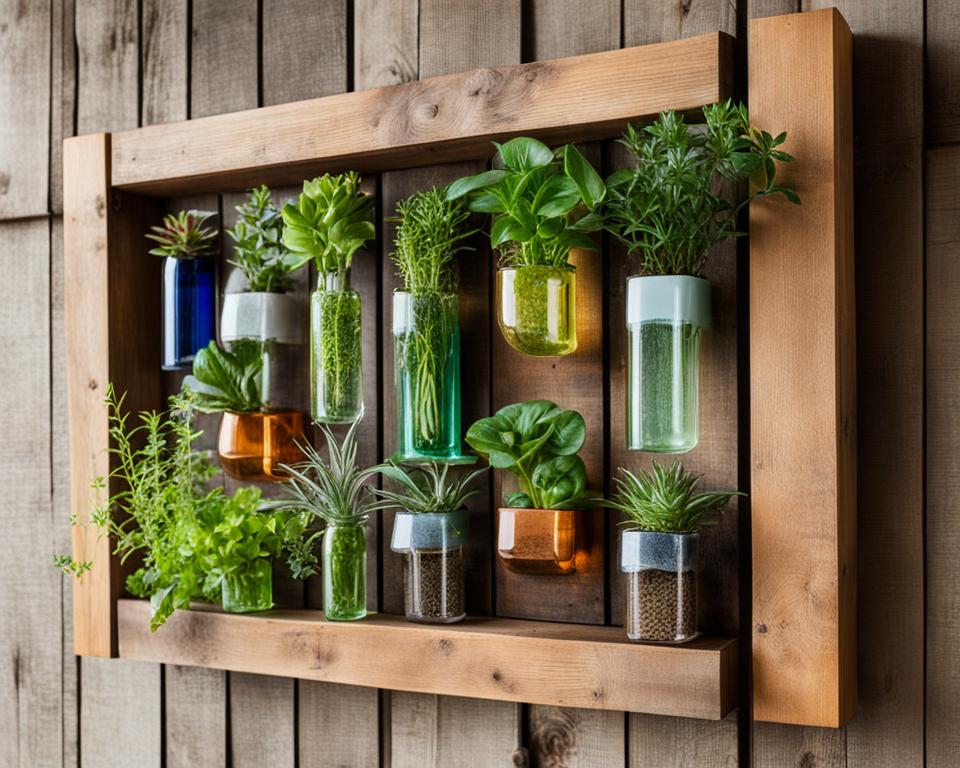Embrace the elevation of greenery with vertical gardening DIY planters, a creative and chic solution to cultivating your dream garden in the smallest of spaces. Whether you’re looking to spruce up a balcony, fence, or wall, these vertical gardening ideas will help you achieve a flourishing oasis that’s as functional as it is enchanting. Crafting a DIY planter box not only saves space but also allows for personalizing your outdoor area to match your aesthetic desires. With an array of homemade planters, the possibilities are endless, from hanging herb gardens to a lush vegetable patch that climbs towards the sky. Dive into the world of vertical garden design and transform your living space into a vibrant green retreat.
Key Takeaways
- Discover space-saving solutions through innovative vertical garden designs.
- Learn how to create personalized DIY planter boxes for your unique space.
- Gain insight into selecting the right materials for durable homemade planters.
- Explore creative ideas to customize your vertical gardening experience.
- Understand the advantages of vertical gardens for urban living environments.
Embracing Vertical Gardening: A Comprehensive Guide
As cityscapes continue to expand, the gardening landscape is ascending new heights. Vertical gardening, a game-changing approach to cultivating plants in urban environments, stands at the forefront of green innovation. Perfectly suited for the spatially-conscious urbanite, vertical gardening provides space-saving gardening solutions that allow for a flourish of greenery without the extensive horizontal footprint.
Transforming Limited Spaces into Lush Gardens
Gone are the days when vast yards were needed to express your green thumb. With the assistance of vertical gardens, balconies, small patios, and even bare walls can metamorphose into thriving green spaces. Whether it’s utilizing a simple trellis or engaging in creative upcycling, urban gardening has never been so accessible or transformative.
Benefits of Vertical Gardens in Urban Homes
Vertical gardens transcend mere aesthetics; they’re powerhouses for enhancing quality of life amidst the concrete jungle. Their rise brings palpable benefits—air purification, natural insulation and reduced urban noise—positioning them as functional art. In the heart of bustling cities, residents can cultivate serene havens, a testament to the tangible perks of vertical gardens within the urban tapestry.
DIY Versus Traditional Gardening Techniques
Redefining the essence of gardening, vertical techniques offer a refreshing alternative to conventional methods. Those enthusiastic about DIY gardening find it not only a space-efficient endeavor but a rewarding one as well. Versus traditional gardening, the vertical approach ensures accessibility and streamlines maintenance—it’s a solution that seamlessly marries innovation with the timeless pleasure of gardening.
The Essentials of Vertical Gardening DIY Planters
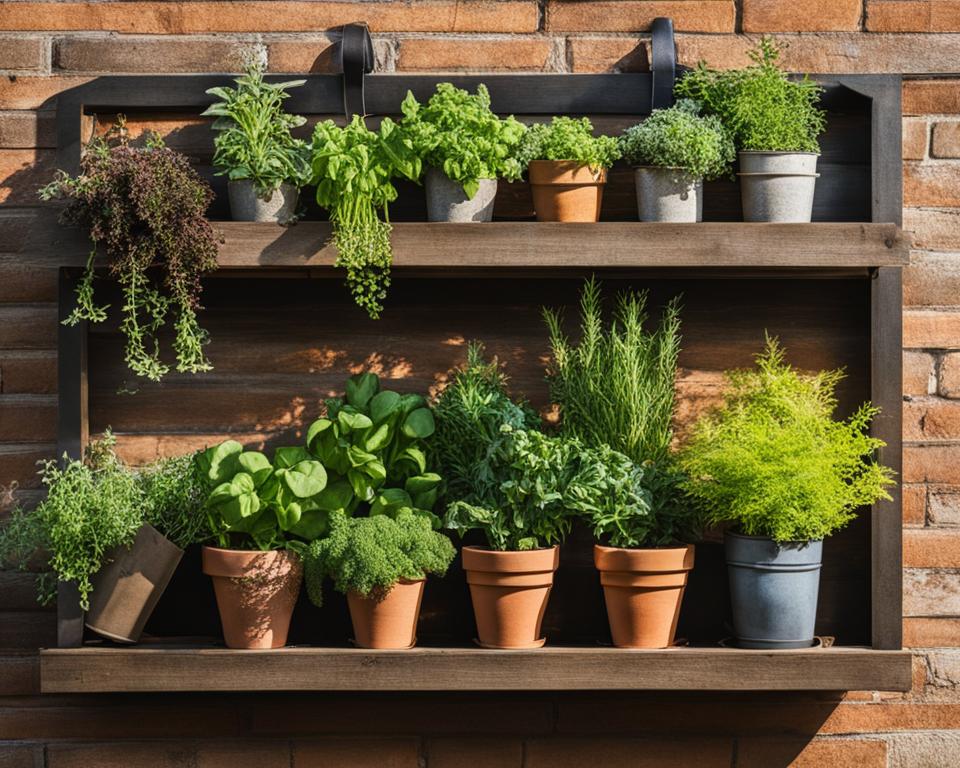
Embarking on DIY vertical gardening might seem daunting at first, but armed with the right knowledge and supplies, your high-rise horticultural dreams are within grasp. Let’s delve into the essentials that are the backbone of successful DIY planters.
You’ll need a framework to secure your thriving greens vertically. The structure should be both robust and visually pleasing, setting the stage for your garden’s aesthetic. Next, invest in planters that are not only well-crafted to hold soil and plants but also echo the design sensibilities of your personal domain.
A well-formulated soil mix is paramount. Container gardening mixtures are readily available and are engineered to yield lush foliage in confined spaces. The presence of basic gardening tools, an efficient watering system that can transcend gravity’s pull, and potential enhancers like fertilizers, all play a critical role in the garden you envision.
Whether you opt for innovative hanging gutter planters or recycle old kitchen spice racks into quaint homes for herbs, these core elements will aid in cultivating a verdant vertical oasis. Follow these vertical gardening tips, and watch as your once barren walls burst into life with green abundance. Here’s a small checklist to keep you on the right track:
- Sturdy vertical support structures such as trellises, wall mounts, or free-standing frames.
- High-quality planters that resonate with your space’s decor.
- A soil mix crafted for the unique needs of container-based plants.
- The right selection of plants that not only grow but flourish vertically.
- Necessary tools to plant, prune, and pamper your vertical garden.
- Watering systems that cater to the distinct hydration needs of vertical flora.
- Optional soil additives such as fertilizer or mulch to enrich your planters.
If you’ve set your sights higher than the traditional garden plot, remember that these elements are your foundation. Whether your thumb is emerald green or just showing its first verdant tint, dipping into the soil of DIY vertical gardening is an exciting endeavor. Follow these guidelines, and your wall will be more than a structure; it will be a living masterpiece.
Creative Vertical Gardening Projects for Beginners
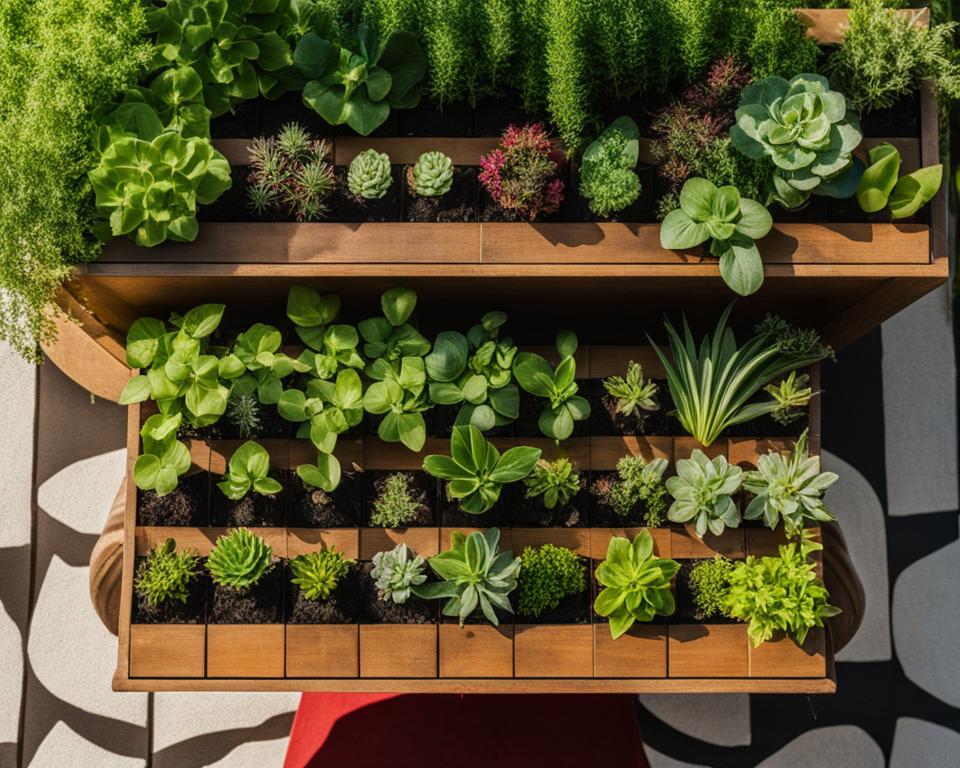
Welcoming you to the world of creative vertical gardening, this guide is tailored for those just starting their journey. Beginning your vertical garden is a delightful endeavor that adds life and freshness to any space. Let’s explore simple and resourceful ways to initiate your DIY vertical gardening projects.
Simple Upcycled Plastic Bottle Tower Garden
One of the most accessible simple DIY garden ideas involves repurposing plastic bottles into a vertical tower. Here’s a straightforward method:
- Cut the bottoms off several large plastic bottles.
- Stack them on top of each other, bottle neck to base, to create a tower.
- Fill each bottle with soil and plant your chosen seeds or seedlings.
- Secure the tower against a sturdy surface or hang it with appropriate support.
This vertical option conserves space and recycles materials, all while giving you the satisfaction of creating a lush garden tower.
Constructing a Rustic Cedar Ladder Planter
A cedar ladder planter presents a charming and rustic aesthetic. To craft one, you’ll need:
- Two long cedar boards for the sides and several shorter steps.
- Screw the steps to the long boards to form a ladder.
- Attach planter boxes or pots to each step, ensuring they’re level.
This ladder design allows you to grow a variety of plants in a compact and attractive display.
Utilizing Basic Pallets for Chic Cone Planters
For those who fancy a chic, shabby look, pallets can be your go-to material. To create a cone planter, you’ll need:
-
Dismantle a basic wooden pallet. -
Cut the pallet wood into trapezoids for the cone sides and brace pieces for the interior structure. -
Assemble the wood pieces into a cone shape using nails or screws. -
Line the interior with landscaping fabric or chicken wire before filling with soil and planting.
These planters are not only functional but can serve as a distinctive focal point in your garden space.
As you embark on these creative vertical gardening projects, celebrate each step of progress and let your garden become a testament to your ingenuity and love for green spaces. It’s amazing what you can achieve with a few simple materials, a bit of time, and your creative spirit!
Designing a Vertical Garden Space with Style

When you embark on vertical gardening projects, the aesthetic aspect is just as critical as the functional. Intertwining style with utility, vertical garden design allows you to exploit the vertical planes of your home while also crafting an artistic expression unique to your living space. Imagine the elegance of a Moroccan style vertical planter or the playful vibrance of a rainbow-themed garden crafted from a wooden crate. These DIY endeavors mesh the conservation of space with the creation of a visually arresting focal point.
In pursuit of a DIY vertical garden, you need not settle for a utilitarian look; let your personality shine through the color schemes and patterns of your choice. Whether aiming for a minimalist look with sleek lines and muted tones or a bolder statement with bright hues and intricate patterns, your design’s impact is as boundless as your imagination. Below, a table is presented to guide you in choosing the right elements for a vertical garden that doesn’t just grow, but also captivates.
| Design Element | Functionality | Style Factor |
|---|---|---|
| Aquaponic Systems | Integrates self-sustaining fish tank | Elevates garden to a living ecosystem |
| Suspended Pot Systems | Facilitates air circulation and plant growth | Adds a dynamic, floating garden effect |
| Freestanding Tiered Planters | Expands planting space vertically | Creates structured, eye-catching garden tiers |
Your approach to crafting a vertical garden merges ecological wisdom with personal creativity. It’s not just about saving space—it’s about reinventing it. By harnessing a blend of nature and design, your vertical garden will resonate as a signature piece of your home’s exterior ensemble, an oasis that not only invokes tranquility but also ignites inspiration.
The Art of Crafting Homemade Planters
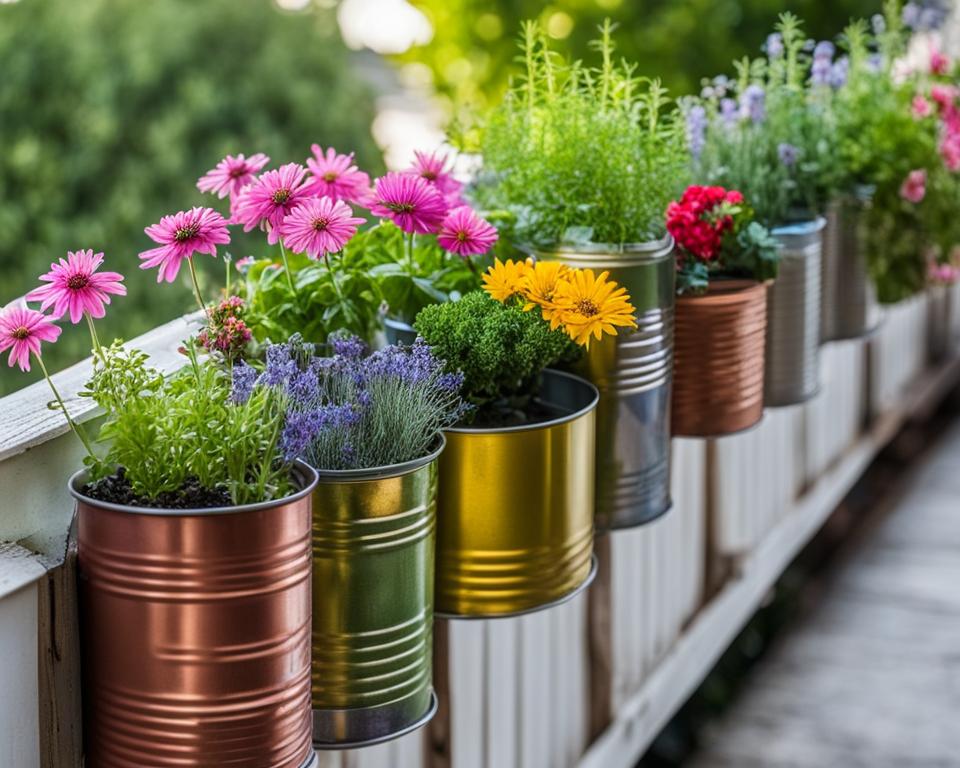
Embrace the satisfaction of crafting your own homemade planters with simple tools and materials. Creating DIY planters not only enhances your home’s aesthetics but also nurtures an intimate connection with the environment. Let’s explore some charming and resourceful ways to fashion your planters that can turn any small corner into a lush space.
Galvanized Buckets: Functional Meets Farmhouse
Galvanized buckets possess a vintage charm that can be seamlessly incorporated into a farmhouse-style garden. These durable containers are excellent candidates for repurposing as hanging planters. They work well with herbs and small flowers, adding a touch of rustic elegance to your outdoor spaces. Mount them on wooden fences or balcony railings to enjoy a functional garden element that also serves as a decor.
Wooden Crate Planters: Aesthetic and Eco-Friendly
Wooden crates, with their natural beauty and rustic appeal, offer a sustainable option for your gardening adventures. These versatile DIY planters can be stacked, painted, or treated to fit any garden theme while supporting a variety of plant life. They are ideal for creating modular planters that can be arranged to optimize your vertical space and are particularly friendly to cascading flora.
Mason Jar Wall Gardens: Small Spaces Solution
For greening up the coziest nooks, mason jar wall gardens present an enchanting and space-efficient solution. These clear jars not only allow you to observe the growth of your plants but also create a visually stunning display when fastened into a repurposed frame. Such gardens are perfect for cultivating herbs, succulents, and other small plants that thrive in contained environments.
| Planter Type | Materials Needed | Ideal Plants | Style Notes |
|---|---|---|---|
| Galvanized Buckets | Metal buckets, hooks/wire for hanging | Herbs, Petunias, Pansies | Rustic, farmhouse chic |
| Wooden Crate Planters | Wooden crates, soil, optional paint or varnish | Small shrubs, vegetables, flower assortments | Natural, stackable, customizable |
| Mason Jar Wall Gardens | Mason jars, mounting structure (frame/wire), soil | Succulents, Cacti, Herbs | Modern, transparent, space-saver |
Crafting DIY planters like galvanized buckets, wooden crate planters, or mason jar wall gardens not only reflects your personal style but also encourages resourcefulness and sustainability. Start your project today and watch as a touch of green breathes life to every part of your home.
Maximizing Your Yield with Vertical Gardening Tips
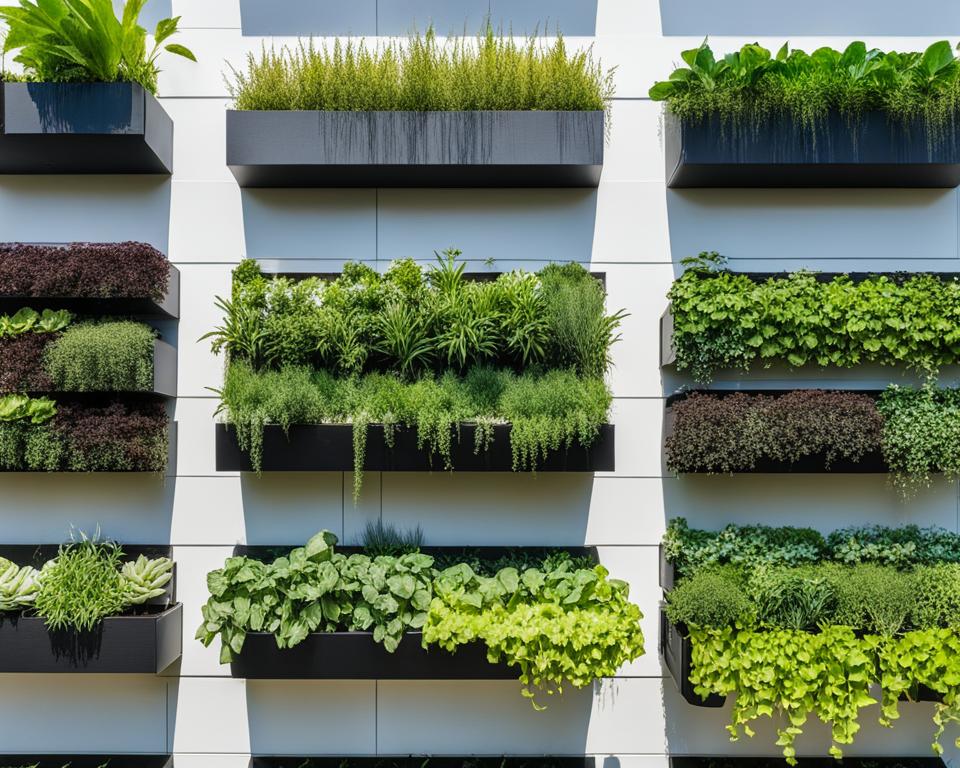
When you delve into the world of vertical gardening, your primary aim may often be maximizing garden yield. This innovative method of cultivation not only expands your growing area but also transforms how you approach garden space optimization. Discover invaluable vertical gardening tips that will enhance the productivity of your garden.
To ensure that you’re making the most out of your vertical garden, start by focusing on plant placement. The right vertical spacing can affect plant growth significantly, allowing each plant to receive ample sunlight and air circulation. Here is a tip: Climbing and vining plants like tomatoes and peas can be trained to grow upwards, which frees up space and results in a cleaner and more manageable garden layout.
- Utilize trellises, stakes, and plant supports strategically to maximize vertical space and ensure proper plant growth.
- Opt for a drip irrigation system to provide a steady supply of water to your plants, which is especially important in vertical setups where soil can dry out quickly.
Choosing the right plant variety is critical to maximizing your yield. Select species that are known to thrive in your climate and that are suitable for vertical growth. Consider the following points:
- Opt for dwarf or compact varieties that naturally need less space to grow.
- Integrate plants that have complementary growth patterns and requirements.
- For high yields in small spaces, look for plants that can be harvested multiple times or that produce abundant crops.
Maintenance is essential in a vertical garden to promote a thriving ecosystem. Pruning and harvesting regularly not only supports plant health but also stimulates additional growth, leading to greater yields.
If you are building your own vertical garden, consider integrating pockets or modular planters that can be easily adjusted or moved. This flexibility lets you experiment with different plant arrangements to find the most productive setup.
Optimize your garden’s exposure to sunlight by rotating the garden structure or the planters themselves. This ensures that each plant gets its fair share of light, crucial for energy production and growth.
In conclusion, maximizing yield through vertical gardening requires a blend of strategic planning, appropriate plant selection, and consistent care. By incorporating these tips into your vertical garden, you’re well on your way to harvesting an abundant and vibrant array of plants from your own optimized garden space.
How to Build a DIY Planter Box That Thrives
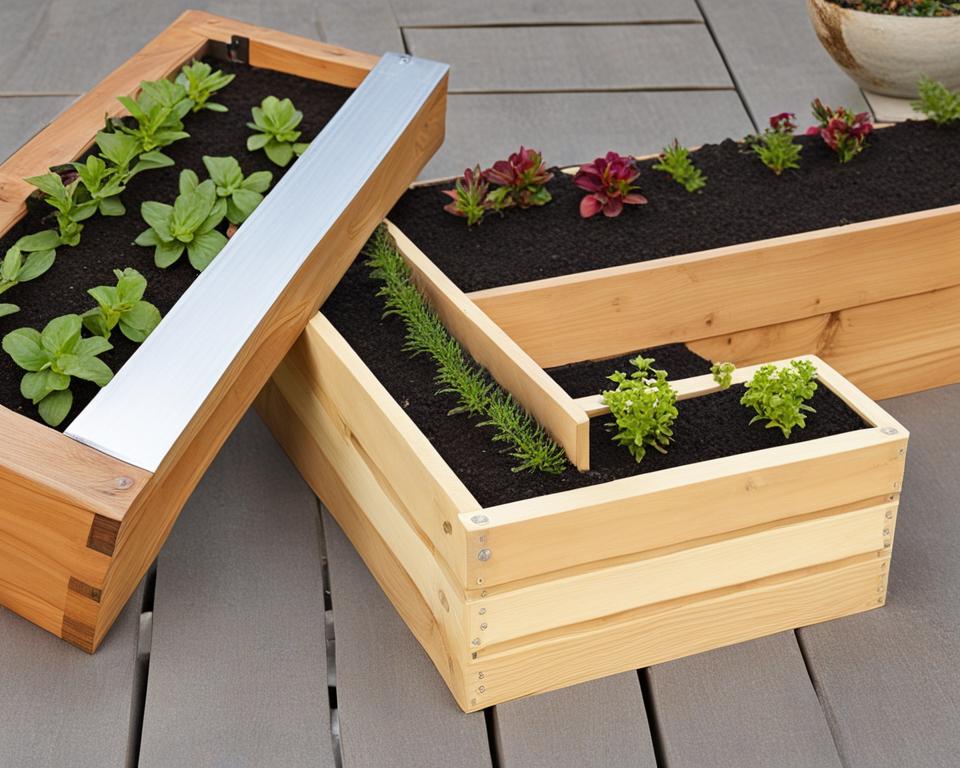
Creating a DIY planter box is a satisfying and practical project for enthusiasts of container gardening. Not only does it beautify your space, but it also contributes significantly to ensuring plant health. Dive into the smart practices for material selection and construction, the art of crafting the right soil mixture, and effective drainage solutions – all essential pillars for a planter box that not only looks good but thrives. Let’s roll up our sleeves and dig into building that perfect home for your greenery.
Material Selection and Construction Best Practices
Choosing the right materials is the first step to a long-lasting DIY planter box. Cedar wood remains a top choice due to its natural rot resistance and aesthetic appeal. PVC, while not as natural looking, offers durability and ease of maintenance. When designing your planter, it’s crucial to allow for ample space for roots to expand and grow. A well-constructed trellis or support system may be integrated for vining plants, enabling them to climb and flourish.
Optimal Soil Mixtures for Container Gardens
Your choice of soil mixture is pivotal to your container gardening success. A blend that ensures proper drainage yet retains moisture is key. Typically, a mixture of peat moss, vermiculite, and compost will provide a nutritious and well-aerated environment for a variety of plants. Pay attention to the specific needs of the plants you intend to grow, as some may require special soil amendments to reach their full potential.
Maximizing Drainage for Healthier Plants
Preventing excess water retention is critical in averting root diseases for healthier plants. Ensure that your planter box has holes at the bottom for water to escape and consider lining the bottom with landscape fabric to prevent soil from washing away while still allowing for drainage. A thin layer of gravel at the base can also promote better water flow. Monitor your watering practices as the right balance is essential for vigorous plant growth.
| Material | Pros | Cons | Best Used For |
|---|---|---|---|
| Cedar Wood | Durable, naturally rot-resistant, aesthetically pleasing | Higher cost than some materials | Organic-inspired gardens, long-term use |
| PVC | Weather-resistant, low maintenance | Less natural look | Modern garden designs, areas with extreme weather conditions |
| Soil Mixture | Customizable, controls nutrients | Requires careful consideration for different plants | All types of planters depending on plant needs |
| Drainage System | Prevents waterlogging, promotes plant health | Requires installation | Every DIY planter box to protect against root rot |
By adhering to these guidelines when building your DIY planter box, you will not only optimize your gardening efforts but also enjoy the fruits of your labor through a vibrant and healthy container garden. Tailor these tips to fit your environment, and soon, your green sanctuary will be the envy of the neighborhood.
Choosing Plants for Your DIY Vertical Garden
When embarking on the journey of edible vertical gardening, your plant choices are vital to the success and beauty of your garden. Selecting plants for vertical gardens demands appreciation for design aesthetics and practical consideration of each plant’s needs and contributions.
Selecting the Right Plants for Aesthetic and Functionality
Beauty and utility should guide your decision when choosing plants. Do you aspire to create a wall of lush foliage or a cascade of vibrant flowers, or are you more inclined towards fresh herbs and vegetables? Consider foliage density, flowering patterns, and the overall growth habits of your plants to ensure they are not only pleasing to the eye but also suitable for vertical growing conditions.
Pairing Plants for Complementary Growth
Effective pairings for complementary growth can lead to a harmonious vertical garden. Pairing should account for factors like sunlight exposure, watering needs, and preferred soil type. Choose plant combinations that share similar requirements yet offer contrast in color, texture, and form, creating an aesthetically diverse and vibrant vertical space.
Incorporating Edible Options into Your Vertical Planter
Edible vertical gardening is not only a visual delight but a culinary adventure. Integrating edible plants—like sweet strawberries, ripe cherry tomatoes, and crisp salad greens—into your vertical garden makes healthy eating convenient and satisfying. Whether you’re making a simple salad or garnishing a gourmet meal, the joy of plucking ingredients from your own garden is unparalleled. Tailor your selections to your climate and personal taste to enjoy a bountiful and tasty harvest.
Strategies for Sustaining a Healthy Vertical Garden
To keep your vertical garden both vibrant and productive, it’s important to embrace proven plant care strategies that contribute to overall garden health. Maintaining the robustness of your vertical oasis involves not just planting and waiting but actively engaging in the care process. Here, we focus on key techniques to help you sustain a vertical garden that’s both a visual delight and an exemplar of horticultural excellence.
Sustaining the Foundation: Regularly checking the support structures of your vertical garden is essential. Over time, weather conditions and the weight of growing plants can compromise the integrity of trellises, frames, or hanging systems. Ensuring these remain stable is paramount to prevent damage to both your garden and property.
Monitoring Moisture and Nutrients: Your plants’ roots require both consistent moisture and access to key nutrients. Use an automated watering system to provide a steady supply of water, but don’t forget to manually check soil moisture levels to avoid overwatering. Tailor your nutrient schedule to the specific needs of your garden, adjusting as necessary for the best results.
- Prune and Tidy: Regular pruning helps to prevent disease, encourages growth, and keeps your vertical garden looking tidy. Remove dead or overgrown foliage to ensure that all plants receive adequate sunlight and airflow.
- Pest Management: Addressing pests early on with eco-friendly solutions, such as neem oil or insecticidal soaps, can help to keep your vertical garden healthy without the need for harsh chemicals.
- Rotation for Even Growth: Rotating plants can create uniformity in sun exposure, making sure that all sides of the vertical garden thrive equally. This can be especially important for gardens with variable light conditions.
By routinely implementing these plant care strategies, you lay the groundwork for sustaining a vertical garden that’s as resilient as it is enchanting. Whether you’re a seasoned gardener or a green-thumb-in-training, understanding the intricate needs of your vertical landscape is key to enjoying a lush and productive green space for years to come.
Innovative Ideas for Creative Vertical Gardening
Unlock the potential of your garden space by embracing the world of creative vertical gardening. With innovative techniques and a splash of artistic flair, you can transform a plain wall or balcony into a spectacular living art piece. Explore the possibilities that come with integrating unique elements that reflect your style while fostering a sustainable ecosystem right in your home.
Integrating Artistic Elements into Garden Design
When you think of adding artistic elements to gardens, it’s about turning your green space into a personal gallery. Use the vertical dimension to hang colorful ceramics that gleam in the sunlight, staining wooden pallets that complements your plants, or attaching patterned stencils that cast stunning shadows. Each choice is a brushstroke on your living canvas.
DIY Aquaponics: Combining Aquaculture with Plant Cultivation
Imagine a self-sustaining ecosystem where fish nourish plants and plants clean the water for the fish. A DIY aquaponics system is not just a garden feature; it’s a conversation starter, a science experiment, and a step toward sustainable living—all wrapped in one. This closed-loop system captures the imagination and entices the senses with the gentle sound of water and the sight of thriving flora and fauna.
Moroccan Style Trellis: Adding Global Flair to Your Garden
Add an exotic touch to your space with a Moroccan style trellis, blending global aesthetics with functionality. Whether it’s framing your trellis with colorful tiles or intricately cut metalwork, these designs can transport you to another world. Every glance out your window becomes a journey to a distant land, filled with the scents and sights of a Moroccan bazaar.
| Feature | Benefits | Materials Suggested |
|---|---|---|
| Artistic Garden Elements | Enhances aesthetic appeal and personalizes space | Ceramics, Pallets, Stencils |
| DIY Aquaponics System | Creates a sustainable ecosystem and educates on environmental science | Fish Tank, Plant Scaffolds, Plumbing Supplies |
| Moroccan Style Trellis | Adds international flair and serves as a focal art piece | Colorful Tiles, Metal Framework, Woodwork |
DIY Solutions: Vertical Gardening on a Budget
Embarking on vertical gardening on a budget is more achievable than you might think. With the right approach and a splash of creativity, you can harness the versatility of upcycling in gardening to craft a sustainable and cost-effective green space. Let’s delve into how recycled vertical garden materials can be your best friends in this economical gardening adventure.
Utilizing Recycled Materials for Garden Construction
Recycling and upcycling play a pivotal role in budget vertical gardening. Not only do they minimize costs, they also divert waste from landfills, making your gardening practice a win-win for your pocket and the planet. Recycled items such as plastic bottles, old car tires, and discarded wood pallets can be transformed into innovative garden planters and structures.
Building Cost-Effective Planters from Upcycled Objects
Upcycling is a cornerstone of sustainable living and a clever budget gardening solution. It involves re-envisioning common household items as potential garden components. An old shoe organizer, for example, can become a fantastic vertical herb garden, while renovated dresser drawers may house a blooming array of succulents and flowers.
Accessing Free Resources and Community Exchanges
Look to your community for free resources that can support your vertical gardening efforts. Freecycle, community swaps, and local gardening clubs are excellent avenues to find materials like seeds, soil, containers, and gardening tools. Sharing resources with fellow garden enthusiasts can significantly slash garden start-up and maintenance costs.
Below is a handy table to help you identify materials that can be repurposed into your vertical garden, along with their potential uses:
| Recycled Material | Potential Use |
|---|---|
| Wooden Pallets | Vertical Plant Wall |
| Plastic Bottles | Hanging Planters |
| Tin Cans | Window Sill Herb Pots |
| Old Ladders | Shelved Container Gardens |
| Broken Ceramics | Decorative Mosaic for Planters |
| Rain Boots | Quirky Flower Planters |
Embrace the concept of vertical gardening on a budget by utilizing what’s already available to you. With some imagination and a little elbow grease, the possibilities are endless. The aim is not just to save money, but also to partake in a rewarding form of upcycling in gardening that benefits the environment as much as it does your home.
Conclusion
As you venture through the rewarding process of completing DIY garden projects, vertical gardening stands as a testament to your ingenuity and dedication to creating a greener living space. It’s a sustainable gardening practice that transforms even the most limited areas into vibrant habitats. The steps you take, from careful planning and design to the selection and upkeep of plants, pave the way for vertical gardening success. Embrace each phase of your project, knowing that you’re contributing to a sustainable future and personal sanctuary.
Your journey in vertical gardening is not just about the beauty you cultivate; it’s also about the sustainable gardening practices you adopt. From reimagining recycled materials into functional planters to selecting flora that thrives upwards, every choice you make fosters environmental stewardship. As you cherish the blooms and harvest the fruits of your labor, take pride in the oasis you’ve created against the backdrop of urban concrete. Your vertical garden is not merely a statement of style but a symbol of resilience and environmental consciousness.
In sum, the vertical garden you have nurtured stands as a lush, living mosaic; a culmination of creativity, sustainability, and growth. Whether you’ve crafted minimalist structures or grand installations, the outcome enriches your home and feeds your spirit. Treasure the transformed view from your window, the biodiversity among your blooms, and the joy in sharing your green retreat with friends and family. Every leaf, petal, and vine in your vertical garden narrates a story of persistence, renewal, and connection to the natural world.
FAQ
What are some benefits of vertical gardening?
Vertical gardening offers numerous benefits including space-saving in urban environments, aesthetic improvement of living areas, creating natural sound barriers, improving air quality, and potentially easier plant maintenance due to better access and less bending or kneeling.
What materials can I use for DIY vertical planters?
You can use a variety of materials for DIY vertical planters, like cedar wood, PVC pipes, galvanized buckets, wooden crates, plastic bottles, and upcycled materials such as pallets and old kitchen spice racks.
How do I select plants for my vertical garden?
Choose plants based on your climate, sunlight exposure, and the aesthetic you want to achieve. Consider a mix of ornamental plants, foliage with different textures, and edible plants such as herbs, strawberries, and cherry tomatoes for functional diversity.
What are some easy vertical gardening projects for beginners?
Some beginner-friendly projects include upcycled plastic bottle tower gardens, a rustic cedar ladder planter, and cone-shaped planters made with chicken wire and reclaimed pallet wood. These projects require minimal tools and materials.
How can I ensure the health of my vertical garden?
Maintain consistent soil moisture, ensure your planters have good drainage, and choose a soil mix that provides nutrients and aeration. Regularly check plant health, prune as needed, and manage pests with eco-friendly solutions. Automated watering systems can also be useful.
Can I create a vertical garden on a budget?
Absolutely! You can minimize costs by using recycled materials, such as old rain boots, tin cans, or wood pallets. Look for second-hand items, community exchanges, or natural materials like stone or driftwood to construct your vertical garden creatively and affordably.
How do I design a vertical garden with style?
Integrate visual interest through color schemes, textures, and patterns. Consider artistic elements like painted pallets, colorful containers, or thematic designs. Your design can also include innovative systems such as aquaponics or incorporate cultural inspirations for a unique touch.
How do I build a thriving DIY planter box?
To build a thriving DIY planter box, use durable materials that withstand outdoor conditions, ensure the planter box has enough room for roots to grow, select a quality soil mix, and provide proper drainage. Adding a trellis can support climbing plants as well.
What strategies should I use to maximize my vertical garden’s yield?
To maximize yield, utilize vertical spacing wisely, select plant varieties suited to your climate, ensure adequate sunlight exposure, and consider installing a drip irrigation system. Regular pruning and harvesting can also promote plant growth and improve yield.
How can I maintain my vertical garden’s structure and stability?
Use sturdy supports and secure your planters well to the vertical surface. Check the structure periodically for signs of wear or damage, especially after severe weather conditions. Ensure that the weight of plants and soil is evenly distributed and not straining the supports.

